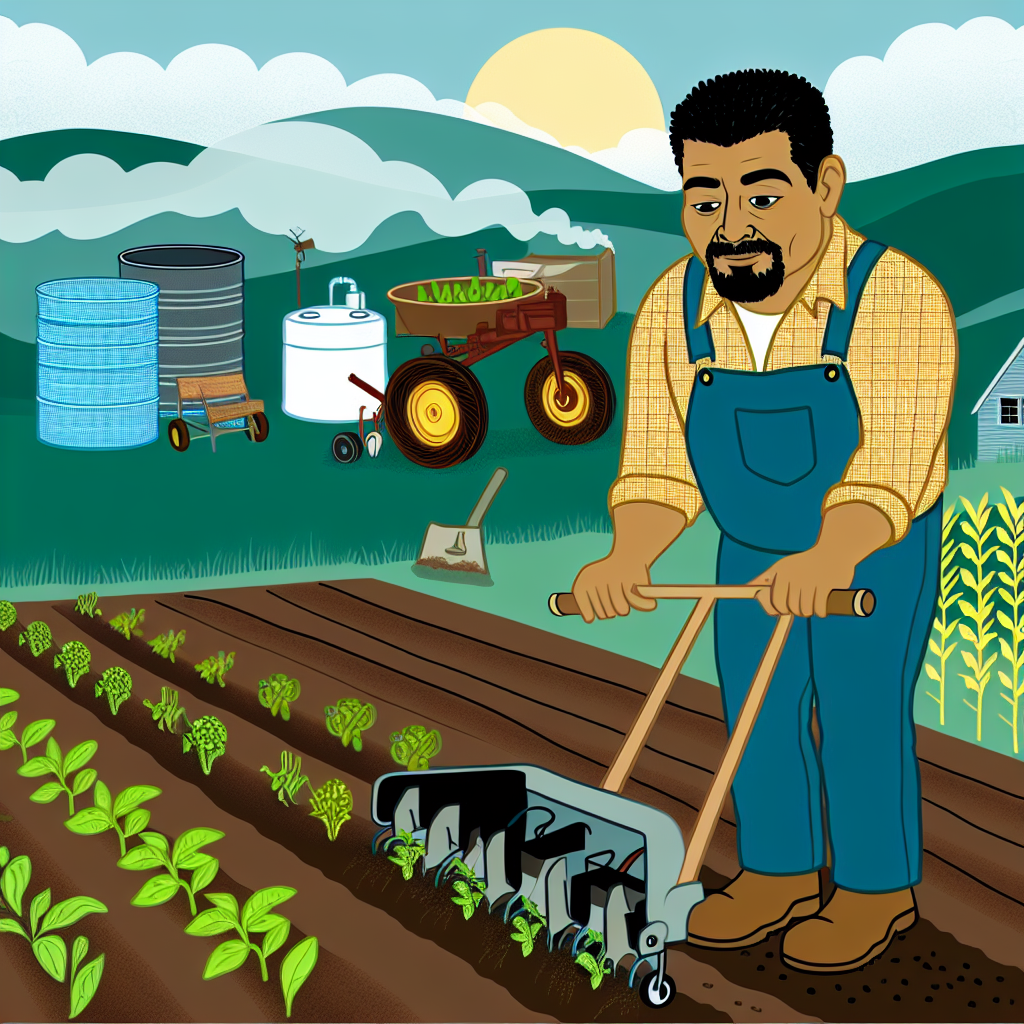Introduction to Sustainable Practices and Their Importance for Small Farms
Sustainable farming practices are essential for modern agriculture.
These methods help maintain the health of the environment.
Moreover, they ensure the viability of small farms for future generations.
Small farms play a vital role in local food systems.
They contribute to the economy by supporting local markets.
Implementing sustainable practices enhances farm resilience.
Farmers can adapt to climate changes more effectively.
This approach promotes biodiversity and protects ecosystems.
Farmers can reduce resource consumption significantly.
Ultimately, sustainable practices lead to healthier food options.
Consumers increasingly prefer sustainable and ethically produced food.
This trend benefits small farms that adopt such practices.
Environmental and Economic Benefits
Adopting sustainable farming practices has profound environmental benefits.
For example, they reduce soil erosion and enhance soil fertility.
Healthy soil supports better crop yields in the long run.
Transform Your Agribusiness
Unlock your farm's potential with expert advice tailored to your needs. Get actionable steps that drive real results.
Get StartedFurthermore, sustainable farming can decrease reliance on chemical fertilizers.
This shift can reduce agricultural runoff and water pollution.
Economically, sustainable practices can lower production costs.
For instance, implementing crop rotation improves soil health.
This method minimizes pests and reduces the need for pesticides.
Consequently, farmers can achieve higher profit margins.
Enhancing Community Engagement
Small farms can strengthen community ties through sustainability.
Farmers can host workshops and community events to educate others.
These activities foster a connection between producers and consumers.
Community-supported agriculture (CSA) programs promote local food availability.
Moreover, these initiatives encourage local economic growth.
Consumers often feel more invested in their local food systems.
Consequently, small farms can gain loyal customer bases.
This mutual support enhances the resilience of local economies.
Soil Health Management
Why Soil Health Matters
Soil health is crucial for sustainable farming practices.
Healthy soil supports robust crop growth and biodiversity.
It also enhances water retention and reduces erosion.
Moreover, vibrant soil ecosystems contribute to nutrient cycling.
Techniques for Improving Soil Fertility
Crop rotation is an effective method to enhance soil fertility.
This practice prevents nutrient depletion and pest buildup.
Additionally, integrating cover crops can enrich soil organic matter.
Leguminous plants, for example, fix nitrogen in the soil.
Enhancing Soil Structure
Soil structure significantly impacts water movement and aeration.
Incorporating organic amendments can improve soil texture.
Showcase Your Farming Business
Publish your professional farming services profile on our blog for a one-time fee of $200 and reach a dedicated audience of farmers and agribusiness owners.
Publish Your ProfileCompost is a great resource to enhance soil structure.
Furthermore, reduced tillage minimizes soil compaction.
Microbial Health and Soil Fertility
Supporting beneficial microbes is essential for soil vitality.
Inoculating soil with mycorrhizal fungi fosters plant growth.
These fungi enhance nutrient absorption and resilience.
Regularly testing soil can help manage microbial communities.
Utilizing Natural Mulches
Applying organic mulches maintains soil moisture and temperature.
They help suppress weeds and add organic matter over time.
Straw, wood chips, and grass clippings serve as effective mulches.
Additionally, mulches can support beneficial insects and organisms.
Minimal Soil Disturbance
Practicing minimal tillage protects soil structure.
This method encourages earthworm activity and organic matter retention.
It helps to prevent erosion caused by excessive plowing.
Cover cropping and no-till practices complement minimal disturbance.
Implementing Integrated Pest Management
Integrated pest management helps maintain soil health indirectly.
By controlling pests, it reduces the need for chemical inputs.
Naturally reducing pest populations encourages soil organisms.
Using companion planting also promotes soil biodiversity.
Water Conservation Strategies
Efficient Irrigation Systems
Efficient irrigation systems are crucial for modern small farms.
They help farmers use water wisely while promoting healthy crops.
Drip irrigation is one of the most efficient systems available.
This method delivers water directly to the roots of plants.
It minimizes evaporation and runoff, saving valuable resources.
Moreover, farmers can customize drip systems to suit various crop needs.
Another effective approach is a sprinkler irrigation system.
Sprinklers can cover large areas and reduce water waste.
Farmers should consider using smart technology for irrigation control.
Automated systems can adjust watering schedules based on weather conditions.
As a result, they enhance efficiency and reduce water usage.
Rainwater Harvesting
Rainwater harvesting provides an excellent alternative water source for farmers.
This practice involves collecting and storing rainwater from rooftops.
Farmers can use stored rainwater for irrigation or livestock.
Installing rain barrels or cisterns helps capture this precious resource.
Additionally, using permeable surfaces can enhance groundwater recharge.
Farmers should periodically check and maintain their harvesting systems.
This ensures they operate effectively during dry spells.
Overall, rainwater harvesting can significantly reduce dependence on traditional sources.
Implementing Best Practices
Farmers must educate themselves on the latest water conservation techniques.
Regular workshops and courses can provide valuable insights and skills.
Networking with other farmers can also offer practical tips and support.
Showcase Your Farming Business
Publish your professional farming services profile on our blog for a one-time fee of $200 and reach a dedicated audience of farmers and agribusiness owners.
Publish Your ProfileMoreover, government programs may provide financial assistance for irrigation efficiency upgrades.
By applying these best practices, farmers can create sustainable systems.
Ultimately, collaboration and commitment lead to long-term success in water conservation.
Learn More: Transition To Ethical Animal Farming
Crop Diversification
Benefits of Growing Multiple Crops
Crop diversification enhances farm resilience.
By growing varied crops, farmers reduce their risk of total crop failure.
This strategy improves soil health and nutrient cycling.
Additionally, diverse crops can attract beneficial insects.
These insects play a crucial role in natural pest control.
Moreover, multiple crops can lead to higher overall yields.
Farmers often see increased revenue from selling different products.
Improving Soil Health
Diverse cropping systems enhance soil fertility.
Different plants have unique root structures.
These structures aid in preventing soil erosion.
Moreover, they contribute to improved soil structure and moisture retention.
Rotating crops helps disrupt pest and disease cycles.
This minimizes the need for chemical treatments.
Furthermore, legumes can naturally fix nitrogen in the soil.
Case Studies in Diversification
Many small farms have successfully adopted crop diversification.
For example, Green Meadow Farm grows both vegetables and herbs.
This strategy allows them to cater to local markets effectively.
Similarly, Sunny Acres uses a mixture of grains and legumes.
The farm reports improved soil quality and decreased input costs.
Implementation Strategies
Farmers can start diversifying their crops gradually.
Begin by introducing one or two new crop varieties each season.
It’s also essential to research market demands before choosing crops.
Networking with other farmers can yield valuable insights.
Participating in local farmer markets encourages experimentation.
Moreover, attending workshops on sustainable practices can be beneficial.
Long-Term Impact
Crop diversification fosters sustainable farming practices.
This approach leads to a more resilient food system.
Both farmers and communities benefit from increased biodiversity.
Moreover, it promotes environmental stewardship and responsible land use.
Gain More Insights: Building Strong CSA Relationships with Customers
Integrated Pest Management (IPM)
Understanding IPM
Integrated Pest Management is a holistic approach to pest control.
This method combines biological, cultural, and mechanical practices.
IPM aims to minimize the use of chemical pesticides.
Moreover, it focuses on long-term prevention strategies.
Key Components of IPM
Effective IPM practices include monitoring pest populations.
Regular inspections help farmers identify pest problems early.
Showcase Your Farming Business
Publish your professional farming services profile on our blog for a one-time fee of $200 and reach a dedicated audience of farmers and agribusiness owners.
Publish Your ProfileAdditionally, understanding the life cycles of pests is crucial.
This knowledge allows for timely interventions.
Biological Control Methods
Using natural predators can reduce pest populations significantly.
For instance, ladybugs effectively control aphid infestations.
Entomopathogenic nematodes target soil-dwelling pests.
These methods promote biodiversity and reduce chemical reliance.
Cultural Practices
Crop rotation helps disrupt pest life cycles.
Planting pest-resistant varieties can minimize infestations.
Additionally, maintaining healthy soil supports robust plant growth.
Healthy plants are less vulnerable to pest attacks.
Mechanical and Physical Controls
Mechanical controls include traps and barriers.
For example, row covers can protect crops from harmful insects.
Hand-picking pests offers a simple, effective solution.
Moreover, steam sterilization can eliminate pathogens in the soil.
Monitoring and Record Keeping
Successful IPM relies on diligent monitoring methods.
Farmers should maintain detailed records of pest occurrences.
This data aids in making informed management decisions.
Furthermore, it helps track the effectiveness of control measures.
Learn More: Ethical Farming Certifications Explained
Organic Farming Principles
Non-Chemical Crop Production Methods
Organic farming relies on non-chemical methods to enhance crop production.
Practicing crop rotation helps maintain soil fertility.
This method disrupts pest cycles and improves biodiversity.
Additionally, intercropping can maximize land use efficiency.
Plants assist each other in growth, which leads to higher yields.
Soil Health Management
Building healthy soil is crucial for organic farming success.
Farmers should focus on increasing organic matter content.
This can be achieved through the addition of compost and cover crops.
Regular soil testing helps understand nutrient needs.
Furthermore, reducing tillage preserves soil structure and microbial life.
Pest and Disease Control
Organic farming employs a variety of integrated pest management techniques.
Natural predators can control pest populations effectively.
Farmers can also use organic-approved pesticides when necessary.
Monitoring plant health helps detect issues early.
Moreover, using companion planting deters pests and promotes health.
Water Conservation Techniques
Efficient water use is essential for sustainable farming.
Drip irrigation systems can significantly reduce water waste.
Collecting rainwater minimizes dependency on groundwater sources.
Mulching also helps retain soil moisture and prevent erosion.
These practices ensure that water resources are utilized wisely.
Natural Fertilizers and Soil Amendments
Organic farmers often rely on natural fertilizers to nourish crops.
Showcase Your Farming Business
Publish your professional farming services profile on our blog for a one-time fee of $200 and reach a dedicated audience of farmers and agribusiness owners.
Publish Your ProfileCompost enhances soil quality and promotes microbial activity.
Animal manure, when properly managed, offers essential nutrients.
Cover crops like clover can fix nitrogen in the soil.
Regular amendments keep soil health in optimal condition.
Learn More: Advantages Of Ethical Livestock Farming

Agroforestry: Combining Agriculture with Tree Growth for Biodiversity and Profit
Defining Agroforestry
Agroforestry integrates trees and shrubs into farmland.
This practice enhances biodiversity and ecosystem services.
Moreover, it provides additional income streams for farmers.
Benefits of Agroforestry
Agroforestry improves soil health through increased organic matter.
Healthy soil supports crop productivity over time.
In addition, trees reduce soil erosion, protecting vital resources.
Crucially, these systems help to sequester carbon dioxide.
Diversity of Production
Farmers can cultivate a range of crops alongside trees.
Such diversity increases resilience against pests and diseases.
Furthermore, it allows for rotational grazing with livestock.
Examples of Agroforestry Systems
- Silvopasture combines trees, livestock, and forage.
- Alley cropping involves planting rows of trees with crops.
- Forest farming utilizes understory crops under a forest canopy.
Implementing Agroforestry on Small Farms
To begin, assess the existing landscape and design a plan.
Engage with local experts to learn best practices.
Additionally, start small with pilot projects for evaluation.
Finally, monitor results and adapt techniques as necessary.
Financial Aspects
Agroforestry can increase farm profitability through diversification.
Farmers can access different markets for timber and crops.
Grants and subsidies often support agroforestry initiatives.
This approach can yield both ecological and economic benefits.
Community-Supported Agriculture (CSA): Building Local Food Systems and Relationships
Understanding Community-Supported Agriculture
Community-supported agriculture connects local farms with consumers.
Farmers and consumers share the risks and benefits of farming.
This model fosters strong relationships within the community.
Benefits for Farmers
CSAs provide farmers with upfront capital for their operations.
This support helps ensure a stable income during the growing season.
Additionally, farmers can produce crops based on consumer preferences.
Moreover, they benefit from reduced marketing costs.
Advantages for Consumers
Consumers enjoy fresher produce directly from local farms.
Participating in a CSA promotes seasonal eating.
Consumers also gain a deeper connection to their food sources.
Furthermore, they can learn about sustainable farming practices.
Enhancing Local Food Systems
CSAs strengthen local food systems by promoting food sovereignty.
This model reduces reliance on distant food sources.
Additionally, local economies benefit as money stays within the community.
CSAs encourage biodiversity through diverse crop production.
Building Relationships and Community
CSAs facilitate direct communication between farmers and consumers.
This relationship fosters trust and transparency in food production.
Showcase Your Farming Business
Publish your professional farming services profile on our blog for a one-time fee of $200 and reach a dedicated audience of farmers and agribusiness owners.
Publish Your ProfileMoreover, community members often participate in farm events and activities.
These interactions enhance local engagement and community spirit.
Challenges of Community-Supported Agriculture
CSAs face challenges such as varying consumer demand.
Weather conditions can also impact crop yields unpredictably.
Despite these challenges, many CSAs successfully adapt and innovate.
This resilience highlights the importance of community support.
The Future of Sustainable Farming and Its Role in Food Security
Importance of Sustainability in Agriculture
Sustainable farming practices are crucial for ensuring food security.
They help maintain ecological balance and preserve resources for future generations.
Moreover, these practices address pressing issues like climate change and soil degradation.
Innovations Driving Sustainable Practices
Technological advances play a vital role in sustainable agriculture.
For example, precision farming optimizes input use and boosts productivity.
Additionally, vertical farming minimizes land use while maximizing yield.
These innovations foster resilience in food systems worldwide.
The Role of Local Farms in Food Security
Small, local farms contribute significantly to community food security.
They reduce the distance food travels, lowering carbon footprints.
Furthermore, these farms offer fresh produce, promoting healthier diets.
Support for local agriculture helps build stronger, more resilient communities.
Adapting to Changing Trends
As consumer preferences evolve, sustainable practices must adapt.
Consumers increasingly demand transparency and ethical sourcing of food.
Therefore, farmers should embrace practices that meet these expectations.
This adaptability will enhance market viability and customer trust.
Building a Collaborative Future
Collaboration among farmers, governments, and consumers is essential.
Sharing knowledge and resources can amplify sustainable efforts.
Moreover, policies must support innovative agricultural practices.
Such collaboration ultimately strengthens food security at all levels.
Implications for Global Food Systems
In summary, the future of farming relies on sustainability.
It plays a pivotal role in addressing global food security challenges.
By embracing sustainable practices, farmers can ensure a healthier planet.
Collectively, we must advocate for sustainable agriculture for future generations.
Additional Resources
What is Sustainable Agriculture? | Union of Concerned Scientists




